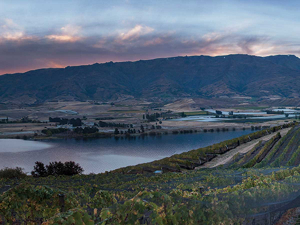“We’re doing really well. I’m convinced that most grapegrowers’ personalities are solar powered, and when the sun comes out, we’re happy.”
In his VineFacts for 19 January, Plant & Food Research’s Rob Agnew notes that as an island nation, seasonal temperature patterns are generally reflected in most regions. But Central Otago’s distance from the coast means its temperatures can be “disconnected” to what is happening elsewhere. “All of us living outside Central Otago are envious of the 30 days that Cromwell has recorded temperatures above 25C from 1 December 2022 to 17 January 2023, with 7 of those days above 30C,” he says in VineFacts number 17.
Unlike most of the country’s rain besieged regions, Central Otago is drying out rapidly, with shelter belts starting to turn and drop leaf. “Canopies are drying out and we need to be a bit more mindful of irrigation,” Timbo says. “We have big old hot days at the moment and no rain in the forecast.” Meanwhile, the diurnal variation has been extreme, with a 26C swing in temperature between day and night on most of the vineyards he contracts to in the second and third week of January. “That’s remarkable this time of the year.”
Timbo says fruit across all the subregions is “incredibly clean”, but notes that turbulent weather over flowering resulted in a lack of uniformity in bunch architecture in some cases, with certain areas more affected more than others. “Mother nature’s thumb print this year will be a little bit more than we would like,” he says, comparing the situation to 2013, where Pinot Noir had the potential for green, red and black flavours “in one bottle”. A focus of the viticultural team at the moment is to avoid that spectrum to make Pinot as “uniform as possible”, he says. The situation makes crop estimates harder to ascertain, “but if they’re the only things we’re complaining about it’s probably a lot more low-level than everyone else”, Timbo says. “I think we’re in line for a really nice vintage.”
Winemaker Matt Connell, of Matt Connell Wines in Cromwell, says there was plenty of soil moisture earlier in the growing season, and January has brought hot days. “It was pretty green earlier on and now it’s looking a lot drier.” He’s welcoming the diurnal fluctuations, noting that years like 2018, without a chilling off in the evening, make for “trickier” vintages. “If we get cool nights, we retain acidity and freshness in the wines, and that’s definitely what I am looking for.” And they’re getting that, along with dry conditions. “I’m definitely not complaining that it’s not raining much.”
Central Otago did get an Antarctic snap in November, when some Chardonnay had hit budburst, but the region’s vineyards were largely unscathed, says Matt. “If it had been a week or two later it may have been a different scenario, but I think everyone got through that very well.” There’s hen and chicken in bunches in some pockets, but there’s been a good fruit set across all the subregions, with “nice” bunch sizes and pretty even crops, says Matt. “Everyone will be happy… I think it’s got the makings of another good season for us, fingers crossed.”
The labour situation for wineries has improved greatly on the past few years, with backpackers returning. “This is the first year I have had an abundance of people applying for vintage positions which is fantastic,” Matt says. “That takes some pressure off, rather than relying on friends and family.” There are issues with housing winery workers, given the crossover between stone fruit and grape seasons, which is a challenge. “But it’s a good challenge to have, that we have labour I guess.”
Timbo says a second wave of Covid-19 took its toll on vineyard staff numbers in January, “but I suspect the rest of the country is dealing with the same thing”. He’s changed the way he manages his operation this season based on a mid-winter report on labour supply. Knowing there’d be a shortage for horticulture in the lead up to Christmas, then a more abundant supply in January, he changed his chemical use and concentrated his labour force on wire lifting and shoot thinning, instead of bud rubbing. “It was good for us to have a few strategies ahead of time to head off that lack of labour,” he says, calling it one of many “forced innovations” in recent years.
Meanwhile, a burgeoning interest in sparkling wine has eased some of the labour pressures in recent years, extending the season by around 20 days. “We managed to start harvest with a much bigger crew and hold them for a much longer period, really based on these bubble projects.”
Well Red
Central Otago’s role as a red grape grower is more important to New Zealand wine than ever, says Viticulturist Timbo Deaker. “We are seeing Pinot Noir and more latterly Chardonnay being pulled out of Marlborough at a rate of knots.” One consequence is more Marlborough companies looking to Central Otago for their Pinot Noir, exacerbating an already short supply. Combined with the rise of Rosé and growth of Pinot going to Sparkling wine, demand is high “and we do not have enough grapes for it”, he says. “That’s a really positive position to be in, but it does create problems for our wine industry.”
The region has been adding 8% to 10% to its planted area each year since 2011, while still growing its price point by 3.5% to 4.5% per annum, says Timbo. “So we’ve been planting sustainably without compromising the regional price point.” But they have struggled to keep up with red grape production. “What does that mean for us as a region? And what does it mean for New Zealand as a Pinot producer? Where are we going to go when there is a red grape shortage?”
Expansion will continue, and he hopes developers consider the needs of Central Otago’s modern growing requirements, including vineyards that require less labour input, with a whopping 62% of the budget per hectare of grape growing in Central Otago currently associated with labour costs. They also have the challenge of designing vineyards that will be “organic proof”, or at the very least able to be glyphosate-free, he adds, describing land with more organic matter and fewer rocks. “I think in the future we will be asked to farm without glyphosate, led by the wine consumer. We’re the only region in New Zealand that hit its target by 2020 of 20% of viticulture farmed with organic certification. We want to increase that but we need to stop and talk about what areas in Central Otago can we farm organically.”














